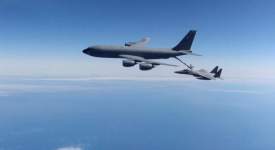Across the globe, countries are rearming – and this is especially true in the Middle East and North Africa (MENA). According to the Stockholm International Peace Research Institute (SIPRI), the region has imported more military equipment in the past decade than all but one other (Asia and Oceania). But countries in the MENA region are not only enthusiastic importers of weapons. They are also increasingly aiming to create indigenous defence capabilities and become exporters themselves. Their goals are to make inroads into the lucrative defence sector, to reduce the pressure on their own budgets by being able to buy domestically, and to support allies across the region with military hardware. This trend will have consequences not only for security in the region but also for Europe and how it deals with states that do not have the same ethical standards as European countries.
Turkey has led the way in such efforts, setting an example that states across the MENA are now emulating. Ankara has reaped the geopolitical benefits of the production and sale of unmanned aerial vehicles (UAVs or drones), especially in terms of security and deterrence capabilities. For example, Turkey has used drones to protect its foreign policy interests in Syria and the eastern Mediterranean – and to extend its influence beyond the region, such as through the support for Azerbaijan, which helped the latter win its 2020 conflict with Armenia over Nagorno-Karabakh. Turkey was able to play this role because it spent years developing solid technological expertise and an industrial base. Other countries are now following suit. For instance, the United Arab Emirates is also developing its own drone industry and has deployed drones to support its allies and proxies in Libya, Yemen, and Ethiopia.
Local companies are now investing heavily in unmanned systems, especially unmanned combat aerial vehicles (UCAVs), as well as loitering munitions (expendable missiles capable of staying airborne for some time until they identify a target and attack). These systems have performed remarkably well in war zones such as Libya and Syria. Turkey’s Baykar and Israel Aerospace Industries have risen through the ranks of global drone manufacturers. They have expanded their market presence thanks to innovative and relatively cheap systems such as the TB-2 UCAV and the Harpy family of loitering munitions, which have already seen extensive use in battle, including in Ukraine. The expendability, affordability, and effectiveness of the Turkish TB-2 have made it the best-selling drone in history.
The region is poised to become one of the largest drone hubs in the world. Without the legal limitations and ethical constraints associated with the use of US- and other Western-made systems, states in the region will capitalise on indigenous drones and loitering munitions to reduce their dependence on Western products. The benefits for them include mitigating the risk of supply chain disruptions, increasing their room for manoeuvre when diplomacy fails to deliver, and establishing advantageous security partnerships with like-minded actors. Loitering munitions are drawing increasing attention because they are more cost-effective medium- and long-range precision strike systems.
For countries in the region, greater indigenous production can help alleviate the fiscal burden on national treasuries by reducing the need for expensive imports and can support national economies by creating highly skilled workforces. And states are throwing their weight behind this effort: in the past year alone, the region has hosted four prestigious defence exhibitions, including the largest one in the world, which recently concluded in Riyadh. Saudi Arabia is aiming to increase its capacity to cover its own defence procurement needs from barely 2% in 2018 to 50% by 2030. The UAE has already developed a capacity to manufacture arms locally, mainly through its state-owned defence conglomerate, EDGE Group (on 23rd place in SIPRI’s top 100 global military and defence manufacturers list). The UAE has become the world’s 18th-biggest arms exporter, ahead of South Africa and Brazil, mostly by selling weapons to customers such as Egypt, Jordan, and Algeria.
Smaller-scale attempts at indigenisation have also boosted Egypt’s and Qatar’s defence industries. At Egypt Defence Expo 2021, Cairo presented the Noot tactical UAV and the forthcoming Thebes-30, a combat drone designed by local firm Industrial Complex Engineering Robots. The same company also produces the EJune-30, a licensed copy of the Emirati-designed Yabhon Flash 20, underlining the strong relationship between Cairo and Abu Dhabi in defence cooperation. In Qatar, the local incubator for military technology, Barzan Holdings, is working on several unmanned systems, including a high-altitude long-endurance drone and unmanned ground vehicles – the latter of which is being produced as part of a joint venture with German defence giant Rheinmetall.
Egypt, Iran, Saudi Arabia, and the UAE are the Middle Eastern states most active in bolstering their own drone fleets with indigenously made platforms. EDGE Group recently developed the Hunter-2 series of portable tactical UAVs and loitering munitions. These are easily deployable, can operate in swarms, and will complement the group’s drone portfolio. EDGE Group is the first Arab company to develop swarming drones with artificial intelligence capabilities. Similarly, Saudi conglomerate INTRA Defence Technologies has unveiled its newest UCAV, the Samoom, which may be a promising solution for the Saudi military and adds to the country’s indigenous Saker UAV family. Both Abu Dhabi and Riyadh have so far relied on Chinese drones such as the Wing Loong I and II, but they could progressively shift towards domestic systems that are easier to maintain and integrate into their command-and-control structures.
Like Turkey and Israel, Iran is positioning itself as a major drone power in the region. Yet Iran’s approach to drone development is remarkably different from that of its neighbours. The country built up its vast drone fleet over many years mainly out of necessity, aiming to compensate for its old and decaying air force, which has been battered by decades of sanctions. Thanks to reverse-engineering and components smuggling, Iran is now able to deploy several types of combat drones and loitering munitions, some of which have beyond-line-of-sight communications and long-range-strike capabilities. However, Iranian drones have remained largely on the margins of the global defence market. For example, Iran has exported an undisclosed number of Mohajer-6s to Ethiopia and has delivered other systems to regional allies such as the Syrian government, Hezbollah in Lebanon, and the Houthis in Yemen. Indeed, for Tehran, the market dimension of drones is of secondary importance to their role in strengthening national security and buoying the regime’s propaganda for both domestic consumption and external deterrence.
Meanwhile, Algeria and Morocco are also hotspots for drone proliferation. Fuelled by their long-standing geopolitical rivalry, the two countries have in recent years significantly strengthened their drone capabilities by acquiring foreign systems. These include Rabat’s purchase of the TB-2 and the Wing Loong I, as well as Algeria’s acquisition of several models of the Chinese CH family. Algeria’s and Morocco’s attempts at indigenisation have been on a smaller scale than those of many other countries in the region. But Morocco remains ambitious in this area: it recently signed a significant aviation deal with the Israel Aerospace Industries that is likely to cover UAV technology.
The proliferation of UCAVs throughout the MENA has not been accompanied by effective regulation of their use; their growth has led to a vast number of civilian casualties and violations of international humanitarian law in all conflicts in the region. This is taking place at a time when overall arms imports by Saudi Arabia, Egypt, and Qatar have risen 27%, 227%, and 73% respectively. These facts should prompt the international community, including the Europeans, to assume a leading role in ensuring the use of drones meets internationally recognised standards of oversight, transparency, and accountability. The European Union has a core interest in developing its own drone technology and preserving and expanding member states’ defence partnerships. However, the EU should also invest its political and diplomatic capital in devising a shared drone accountability regime designed to limit civilian casualties and to make the misuse of such systems intolerably costly.
‘Tools of Influence: Drone Proliferation in the Middle East and North Africa’ — Commentary by Federico Borsari — European Council on Foreign Relations / ECFR.







